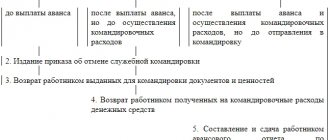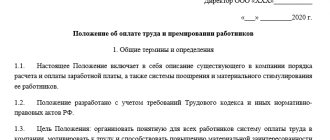Why do we need an order to approve the list of cases?
The legislator in paragraph 1 of Art. 17 Federal Law dated October 22, 2004 No. 125-FZ “On archiving in the Russian Federation” establishes that all enterprises, government bodies, individual entrepreneurs must ensure the safety of all documents that are available, as well as those that relate to personnel, in accordance with the approved deadlines. To comply with deadline requirements, enterprises need to prescribe in their regulations the procedure for creating a system of nomenclature of cases, who will be responsible for this, classify them according to their storage periods, etc.
In order to begin to form a system of nomenclature of cases, it is first necessary to issue an order by the head of the enterprise. The order must be assigned a number according to the developed nomenclature. This document is certified by the manager’s signature and official seal. The order is kept at the enterprise for a certain time.
Order on the introduction of a nomenclature of cases
An order approving the nomenclature of cases, drawn up and signed in accordance with all the rules, gives the nomenclature the status of a valid document. It is a mandatory step in the procedure for adopting the current nomenclature.
Labor law and labor law
Labor law, personnel records management and labor protection
- Home
- /
- Personnel documents
- /
- Other
- /
- We draw up an order to approve the list of cases
We draw up an order to approve the list of cases
Why do we need an order to approve the list of cases? Let's start with what the nomenclature of cases is. This is a document that lists the composition of files formed in the organization, indicating their storage periods.
The nomenclature includes all cases that are opened in the organization, incl. employee statements, certificates of employment, accounting books, correspondence with third-party organizations, etc.
The nomenclature for the coming calendar year is compiled at the end of the current year and this work ends with the issuance of an order approving the nomenclature of cases.
Since this type of order is not unified and is drawn up in any form, I offer you my sample of its execution.
Who draws up the order
The compilation of nomenclature is usually carried out by the office management department. And drawing up an order to approve the list of cases is carried out either by a lawyer, or a personnel employee, or the secretary of the enterprise. That is, in simple words, a person who is endowed with rights, and also has the skills and knowledge to draw up administrative documents.
Important!!! Regardless of who drew up the order, it must be endorsed by the head of the enterprise. Without this, it has no legal force
| ★ Best-selling book “Accounting from scratch” for dummies (understand how to do accounting in 72 hours) > 8,000 books purchased |
Who writes the order
The compilation of the nomenclature is usually carried out by a document specialist or a clerk, but writing an order approving it is the responsibility of another employee: most often this is a legal adviser, a personnel specialist or the secretary of the organization, i.e. a person vested with a certain kind of authority, having knowledge and skills in writing administrative documents.
At the same time, regardless of who was directly involved in creating the order, he must submit the document for approval to the director of the enterprise.
Basic rules for drawing up an order to approve the list of cases
The legislation has not developed or approved a single form, as well as standards for drawing up an order approving the nomenclature of cases. Therefore, enterprises are allowed to compile it in any form, or according to a sample, only for this it must be developed and approved in the accounting policies of the enterprise.
Regardless of which method the enterprise chooses to draw up an order approving the list of cases, it must contain mandatory parameters, namely:
- Number and date when the order was drawn up;
- Full name of the enterprise;
- Information about the approved nomenclature: its number, the year for which it is compiled, as well as other data, if necessary;
- Responsible persons who are responsible for the execution of this order are indicated.
It should be noted that any order must have some basis. In this case, it is enough to write something like: “In order to ensure standards for the content and storage of documents” or provide a direct link to the relevant law.
Important!!! If at the time of drawing up the order to approve the nomenclature for the new calendar year, the previous order is in force, then it must be canceled by the new order drawn up. For example, add a clause to the new order that states the cancellation of the previous order.
Order on introducing a nomenclature of cases in an institution
09/22/2019 Who draws up the order?
If the clerical person is most often involved in compiling the list of cases, then the obligation to prepare the corresponding approval order is assigned to an employee who has experience and relation to the process of issuing administrative acts within the organization. Such persons may be personnel employees, secretaries or employees of legal departments.
Regardless of the entity preparing the approving order for the list of cases, the document in its completed form must be submitted for approval to the first manager. About validity periods The period of operation of a document is usually equal to the period of existence of the item itself.
Important
IN
The procedure for approving the list of cases in the organization
Approval of the nomenclature of cases is an important stage in organizing office work. We analyze the features of the approval order and offer to download various sample versions. Nomenclature is a document that systematizes the entire document flow of the enterprise. Approval of the developed nomenclature of cases can be done in two ways:
- Issuance of an approving order.
- Placing the stamp “APPROVED” directly on the item itself. This method is specified in the order on its creation and development.
Both the first and second methods are acceptable and used in practice.
With a small document flow, it makes no sense to create a nomenclature. Documents are usually grouped into files by large companies, where their number can number hundreds. Issuing an order to approve the list of cases is a periodic event.
Clerk's cheat sheet
The nomenclature of cases and instructions for office work are the two main documents of the clerk. There is no need to change the instructions at the beginning of the year.
This should be done when more than enough innovations have accumulated, and you are already confused in the orders for changes. But the list of cases needs to be re-approved at the beginning of each year. It is better to start the process of updating the nomenclature in November, so that you do not have to finalize the document at the beginning of next year.
Approval of a new nomenclature consists of the following stages: Collection of information from departments about cases that were opened during the year, as well as about cases that are subject to exclusion from the nomenclature. Checking the correctness of the compilation of nomenclatures of structural units. Adding new cases to the consolidated nomenclature and eliminating unnecessary ones.
Adjustment of sections and headings. Check to see if the names of departments have changed or if the structure of the organization has changed.
Basic rules for drawing up an order to approve the list of cases
To date, there are no strict rules for the formation of an order to approve the nomenclature of cases. The enterprise is independently formed in any form, either in handwritten form or in printed form. The order is issued on sheet A4 or A5, or can also be issued on the company’s letterhead.
Please note: the order must have the original signature of the head of the enterprise or his replacement.
A stamp on the order is not necessary, since it is considered an internal document of the enterprise. But if necessary, a stamp is affixed. Since 2020, the legislation has abolished the use of seals and stamps for legal entities.
The order is stored in a specially designated place, along with other administrative documents, for the entire period of its validity. After the order has lost its effect, it must be redirected to the enterprise archive and stored there for the entire time allotted for storage. After the expiration of the archived storage period, the order must be disposed of according to a specially developed procedure.
There are two options for wording the order:
- “ approval and enactment of the nomenclature of cases attached to the order ” - accordingly, the nomenclature of cases is placed as an appendix along with the order when it is filed in the file;
- “ Enactment of the nomenclature of affairs ”, while the nomenclature itself is approved directly by the director, and there is no need to attach it to the order on the main activity.
Next, we provide samples of orders regulating the process of approving the nomenclature of cases.
CLOSED JOINT STOCK COMPANY "FLYING ARROW"
CJSC "Flying Arrow"
Sample of drawing up an order for approval of the list of cases
The order consists of three parts; we will consider each in detail in the form of a table:
| Name of part of the order | What information is indicated in each part of the order? |
| The first part, in other words, the “hat” | Full name of the enterprise where the order is created; The order number is entered according to the internal document flow; Date of the order; The name of the locality where the order is drawn up. |
| Main part | From the beginning, the basis for the order is indicated, that is, it is necessary to indicate the specific purpose of the order; After the word “I order,” the facts are listed in separate paragraphs, where instructions are given to the heads of structural units, and a responsible person is appointed who will be responsible for the execution of the order. This order can be expanded by adding additional orders. For example, if a previous order for an item is in effect, it can be canceled in this order. |
| Final part | In this part of the order, the head of the company certifies with his signature the drawn up order, as well as the persons appointed responsible for its preparation. |
Kinds
The nomenclature of cases is of three types:
- standard (this is a normative document that determines the composition of cases processed in similar organizations);
- approximate (determines the approximate composition of cases and their indexes in the organizations to which it applies);
- individual (each company develops it independently, taking into account the approximate and standard one).
In companies that do not have structural divisions, one nomenclature is compiled. It indicates the titles of all cases opened in the company during the calendar year. At large enterprises, each structural division has its own, and later they are combined.
An example of a completed order for approval of the list of cases
Furniture House LLC
Order No. 25
On approval of the list of cases for 2020
12/19/2017 Krasnodar
To implement legally established standards for the content and storage of documents, as well as systematize their accounting
I ORDER:
- Approve the list of cases of Furniture House LLC and put it into effect from 01/01/2020;
- Heads of departments, as well as structural divisions, formulate a case in accordance with the appropriate approved procedure and current nomenclature;
- Control over the execution of the order is entrusted to the secretary-clerk Oksana Viktorovna Shestakova.
Director of Furniture House LLC Shiryaev Shiryaev K.S.
Shestakova O.V. was familiarized with the order.
Why do we need a nomenclature and an order for its approval?
To fully understand the role of the order, you should first understand the purpose of the nomenclature itself.
The nomenclature is a document that reflects a complete list of matters, including various types of internal papers of the organization.
It does not apply to strictly mandatory documents, and, as a rule, is widespread in large enterprises and government agencies. Representatives of small businesses acquire it much less often, which, in general, is quite understandable and logical.
In large companies with a large staff and many structural divisions, all documents are placed in certain folders, each of which is called a “case” . The number of such folders can reach several hundred .
In order to organize their accounting, a special document in which the following are entered:
- names of cases;
- date of commencement of their maintenance;
- shelf life;
- number of volumes, etc. information.
At the same time, the nomenclature includes those cases that are currently being conducted and those that are already somewhat outdated.
The nomenclature is a periodic document and is compiled, as a rule, once a year - usually in December, for the next year. This regularity allows the company administration to know exactly what documents the organization is entering the next reporting period with.
Sometimes, especially in budgetary institutions, after drawing up the nomenclature, it is agreed upon and approved by a specially created commission. However, in commercial structures, this rule is not always observed - here, quite often, the management of the enterprise makes do with only the appropriate approving order issued on behalf of the director.
The order not only puts the nomenclature into effect, but also makes it possible to ensure the obligation prescribed by law for the proper content and storage of current and archival files.
Examination of the value of documents
As a rule, the information in most documents has a one-time value and after use loses its relevance. And documents containing scientifically and practically valuable information must be stored permanently. For the optimal selection of valuable documents, an examination is carried out from the standpoint of determining the state, socio-cultural and other significance of documents in order to select them for state storage or to establish the terms of their storage. The commission is created by order of the head from the most qualified specialists, as well as the head of the office, departmental archive and chief accountant. The main tasks of the expert commission are: review of draft classifiers and office work nomenclatures.
How to fill out the form
What was above is abstract information. Now we will show specifically what the list of cases in a preschool educational institution should look like for 2020 according to the Federal State Educational Standard, a sample of which can be downloaded for free below.
Let's start with the fact that the Federal State Educational Standards are federal state educational standards. In relation to preschool educational institutions, this is Order No. 1155 of the Ministry of Education and Science of Russia dated October 17, 2013, which reveals this standard in detail. If we look into it, we will see four sections, the first of which is general provisions. It is not relevant to our question. But the other three can be hired based on requirement:
- to the structure of the educational program;
- terms of implementation;
- results of mastering the program.
That is, our nomenclature will consist of at least three items (actually more, but more on that later).
Let's assign an index and name to each case.
Case index according to the nomenclature of cases (sample):
- 01 - structures of educational programs;
- 02 - progress in the implementation of educational programs;
- 03 — results of mastering educational programs.
Next, if we do it for a specific department, then we will assign a further index to this department, for example, the office index - 01. It will appear before the case number, because the weight of the department index is higher (it’s easier to search). As a result we get:
- 01-01;
- 01-02;
- 01-03.
Now, when filling these folders with specific documents, we will assign them numbers using a slash or a line:
- 01-01/… we start from one until the end of the year;
- 01-02/…;
- 01-03/….
The nomenclature of cases in the preschool educational institution for 2020 with new storage periods must be approved no later than the beginning of the new calendar year.
Sample list of cases for 2020
Drawing up a list of cases
1.1. The nomenclature of cases is a systematized list of headings (names) of cases filed by the Ministry of Education and Science of the Russian Federation (hereinafter referred to as the Ministry), indicating their storage periods, drawn up in the prescribed manner.
The nomenclature of files is intended for grouping executed documents into files, systematizing and recording files, determining their storage periods, and is the basis for compiling inventories of permanent and temporary (over 10 years) storage cases, as well as for recording temporary (up to 10 years inclusive) storage cases.
1.2. When compiling a list of files, one should be guided by the regulations on the Ministry and its structural divisions, the staffing table, work plans and reports, lists of documents indicating their storage periods, and file lists for previous years. The documents generated in the activities of the Ministry, their types, composition and content are studied.
1.3.
The Ministry compiles nomenclatures of affairs of structural divisions (Appendix No. 23 to the Instructions for office work in the Ministry of Education and Science of the Russian Federation, approved by order of the Ministry of Education and Science of the Russian Federation dated December 30, 2011 N 2917) and a consolidated nomenclature of affairs of the Ministry (Appendix No. 24 to Instructions for office work in the Ministry of Education and Science of the Russian Federation, approved by order of the Ministry of Education and Science of the Russian Federation dated December 30, 2011 N 2917).
1.4. Structural divisions annually, no later than November 15 of the current year, develop a draft nomenclature of affairs for their division for the next year.
The nomenclature of affairs of a structural unit is compiled by the person responsible for maintaining the office work of the structural unit, agreed with the office work department of the Department of Civil Service, Personnel and Business Administration of the department, the archive department of the Legal Department, signed by the head of the structural unit and submitted to the office work department of the Department of Civil Service, Personnel and Business Management .
The newly created unit is obliged to develop a nomenclature of the unit’s affairs within a month and submit it to the office management department of the Department of Civil Service, Personnel and Business Administration.
Responsibility for organizing the timely compilation of a list of cases and its submission to the office management department of the Department of Civil Service, Personnel and Business Administration rests with the heads of structural divisions. Heads of structural units are required to submit a list of cases in a timely manner.
The nomenclature of cases of a structural unit is prepared in three copies, of which the first copy remains in the records management service of the structural unit, the second and third copies are transferred to the records management department of the Department of Civil Service, Personnel and Case Management and to the archive department of the Legal Department, respectively.
1.5. The consolidated nomenclature of affairs of the Ministry is compiled by the Department of Civil Service, Personnel and Administration on the basis of the nomenclatures of affairs of structural divisions.
Methodological assistance in compiling a consolidated nomenclature of the Ministry’s cases is provided by the archive department of the Legal Department and the Central Expert Commission of the Ministry (hereinafter referred to as the CEC).
Once every 5 years, the consolidated nomenclature of the Ministry’s files is agreed upon with the expert verification commission (hereinafter referred to as the EPC) of the State Archive of the Russian Federation. In the event of a change in the functions and structure of the Ministry, the consolidated nomenclature of cases is subject to revision and coordination with the EPC of the State Archives of the Russian Federation.
1.6. The consolidated list of affairs of the Ministry is signed by the director of the Department of Civil Service, Personnel and Business Administration, agreed upon with the head of the archive department of the Legal Department, with the Central Executive Committee of the Ministry, approved by the Minister of Education and Science of the Russian Federation no later than the end of the current year and put into effect on January 1 of the next year.
1.7. After approval of the consolidated nomenclature of cases, the structural divisions of the Ministry receive extracts from the relevant sections for use in their work.
1.8.
The consolidated list of files is prepared in at least four copies: the 1st copy as a permanent storage document is placed in the file of the Department of Civil Service, Personnel and Business Administration, the 2nd copy is used in the Department of Civil Service, Personnel and Business Management as a working copy, 3 1st - used in the archive department of the Legal Department, 4th - in the State Archive of the Russian Federation, a copy - transferred to the structural unit (organization) providing technical support for the Ministry's SEDKP. A working copy of the consolidated nomenclature of cases is maintained in the Department of Civil Service, Personnel and Case Management in electronic form.
1.9. The consolidated list of cases at the end of each year is specified, approved and put into effect on January 1 of the next calendar year.
1.10. A consolidated list of cases is drawn up and re-agreed in the event of fundamental changes in the functions and structure of the Ministry.
1.11. The names of sections of the nomenclature of affairs of the Ministry are the names of structural divisions. In the consolidated nomenclature of cases, sections are arranged in accordance with the approved structure of the Ministry.
1.12. The nomenclature of cases includes case titles reflecting all documented areas of the Ministry’s work.
The list of cases does not include periodicals.
1.13. The columns of the nomenclature of cases are filled out as follows.
In column 1 of the nomenclature of cases, the indexes of each case included in the nomenclature are entered. The case index consists of the digital designation of the structural unit established by the Ministry and the serial number of the case title according to the nomenclature within the structural unit.
Case indexes are indicated by Arabic numerals.
For example: 03-02-05, where 03 is the designation of the structural unit, 02 is the designation of the staffing department in the structural unit responsible for writing off the relevant documents and creating the case, 05 is the serial number of the case title according to the nomenclature.
In the nomenclature of cases, it is recommended to maintain the same indexes for homogeneous cases within different structural divisions; for moving cases, the index is retained.
Column 2 of the nomenclature of cases includes the titles of cases (volumes, parts).
The title of the case must clearly reflect in a generalized form the main content and composition of the documents of the case.
The use of non-specific wording (“miscellaneous materials”, “general correspondence”), as well as introductory words and complex phrases in the title of the case is not allowed.
The title of the case consists of elements arranged in the following sequence: name of the type of case (correspondence, journal) or type of documents (protocols, orders); name of the Ministry or structural unit (author of the document); name of the organization to which the documents will be addressed or from which the documents will be received (addressee or correspondent of the document); summary of the case documents; name of the locality (territory) with which the content of the case documents is associated; date (period) to which the case documents relate.
In the headings of cases containing documents on one issue, but not related by the sequence of execution, the term “documents” is used as the type of case, and at the end of the title in brackets the main types of documents that should be grouped in the case (plans, lists, reports) are indicated. .
For example: “Documents on thematic exhibitions (plans, lists, reports, characteristics of exhibits).”
The headings of cases containing correspondence indicate with whom and on what issue it is being conducted.
In the headings of cases containing correspondence with similar correspondents, the latter are not indicated, but their general specific name is indicated.
For example:
“Correspondence with federal executive authorities on draft development programs for industrial complexes in the regions.”
In the headings of cases containing correspondence with various correspondents, the latter are not listed.
For example:
“Correspondence on the support and protection of domestic producers in commodity markets.”
The title of the case indicates a specific correspondent if correspondence is carried out only with him.
For example:
“Correspondence with VNIIDAD on issues of scientific and methodological work.”
When designating administrative-territorial units in the headings of cases, the following is taken into account: if the content of the case concerns several homogeneous administrative-territorial units, the title of the case does not indicate their specific names, but their general specific name.
For example:
“Correspondence with heads of regional administrations on social protection of the population.”
If the content of the case concerns one administrative-territorial unit (settlement), its name is indicated in the title of the case.
For example:
“Correspondence with the branch of RGANTD (Samara) on the use of archival documents.”
The headings of cases containing planning or reporting documentation indicate the period (quarter, year) for which plans (reports) were drawn up.
For example:
“Annual reports of JSC “Bolshevsky Textile” on the work of motor transport.”
If the case consists of several volumes or parts, then a general title of the case is drawn up, and then, if necessary, the headings of each volume (part) are compiled, clarifying the content of the title of the case.
The order of the case headings within the sections and subsections of the nomenclature of cases is determined by the degree of importance of the documents that make up the cases and their relationship. First are the headings of cases containing organizational and administrative documentation.
Case titles may be clarified during the process of forming and filing cases.
Column 3 of the list of cases is filled in at the end of the calendar year.
Column 4 indicates the storage period of the file, the numbers of articles according to the list, and in its absence - according to the standard or approximate nomenclature of files or the storage period agreed with the Federal Archive Agency (hereinafter referred to as Rosarkhiv).
Column 5 “Note” indicates the names of the lists of documents used in determining the storage periods for cases, marks are made about the establishment of cases, about transferring cases (for example, transferring from 2010), about the allocation of cases for destruction, about the persons responsible for the formation of cases, on the transfer of cases to another federal executive body for continuation, and more.
1.14. If during the year new documented areas of work or unforeseen cases arise in the federal executive body, they are additionally added to the nomenclature. For newly opened cases, reserve numbers are left in each section of the nomenclature.
1.15. At the end of the year, at the end of the nomenclature of cases, a final record is made about the number of opened cases (volumes).
Source: https://sudact.ru/law/prikaz-minobrnauki-rossii-ot-30122011-n-2917/prilozhenie/prilozhenie-n-21/1_1/
Content
The order to compile a list of cases must contain:
- deadlines for submitting the draft nomenclature of cases of structural divisions (if any) and the consolidated nomenclature of cases:
- Full name and position of the persons responsible for the development;
- the date the project was submitted to the expert commission of the archival institution for approval;
- Full name and position of the person responsible for executing the order.
The document usually contains:
- date of introduction of the new nomenclature of cases;
- Full names and positions of persons responsible for work in accordance with the approved nomenclature;
- Full name and position of the person responsible for executing the order.
https://www.youtube.com/watch?v=ytcreators
The head of the enterprise must sign the order and certify it with a seal.









